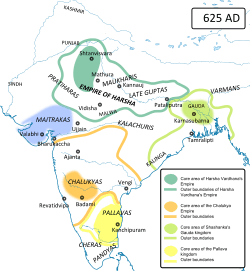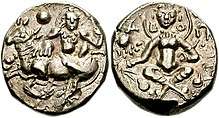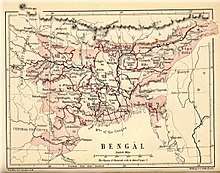Gauda Kingdom
Gauḍa Kingdom (Bengali: গৌড় রাজ্য Gāuṛ Rājya), was a Hindu power during the Classical period on the Indian subcontinent, which originated in the region of Bengal (modern-day Bangladesh and West Bengal)[1][2] in 4rd century CE or possbly earlier.[3]
Kingdom of Gauḍa Bengali: গৌড় রাজ্য (Gāuṛ Rājya) | |||||||||||
|---|---|---|---|---|---|---|---|---|---|---|---|
| 4rd century CE (before 320 CE)–626 CE | |||||||||||
 Royal Seal
| |||||||||||
 Gauda (in eastern India) and its contemporaries, c. 625 CE | |||||||||||
| Capital | Karnasuvarna (present day West Bengal, India) | ||||||||||
| Religion | Hinduism Buddhism | ||||||||||
| Government | Monarchy | ||||||||||
| King | |||||||||||
• 4rd century CE | Loka | ||||||||||
• 590– 625 | Shashanka | ||||||||||
| History | |||||||||||
• Established | 4rd century CE (before 320 CE) | ||||||||||
• Disestablished | 626 CE | ||||||||||
| |||||||||||
Location and extent

A Buddhist Mahayana Text Manjusri Molakalpa records the existence of Gauda Kingdom in Bengal before it was replaced by Gupta Empire in the 4th century. King Loka who was born in Vardhamana (Bardhaman) is mentioned who must have ruled in the early 4th century CE.[4]
King Shashanka (Bengali: শশাঙ্ক Shôshangko) is often attributed with creating the first separate political entity in a unified Bengal called Gauda. He reigned in 7th century, and some historians place his rule approximately between 590 and 625. His capital was at Karnasubarna, 9.6 kilometres (6.0 mi) south-west of Baharampur, headquarters of Murshidabad district.[1]
The Chinese monk, Xuanzang (Hiuen Tsang) travelled from the country of Karnasubarna to a region in the present-day state of Orissa ruled by Shashanka.[2] There is mention of Pundravardhana being part of Gauda in certain ancient records.[5]
According to some sources the city of Gauda was founded by King Shankaladeva. He, originally, was a native of either Pragjyotisapura or Kannauj. Raibahadur Padmanath Gohain Baruah, in his book Asamar Buranji (1899AD), mentioned that a king from Pragjyotisapura, named Shankaladeva, established the city of Gauda. In another book, History of Hindostan (originally translated from the book Gulshan-i-Ibrahimi written by Firishta), it has been stated that Shankaladeva (Sinkol) was a native of Kannauj (Kinoge) and established the city of Gauda during the 8th century BC.[6]
Evidence seems to be discrepant regarding links of Gauda with the Rarh region. While Krishna Mishra (11th or 12th century), in his Prabodha-chandrodaya, mentions that Gauda Rashtra includes Rarh (or Rarhpuri) and Bhurishreshthika, identified with Bhurshut, in Hooghly and Howrah districts, but the Managoli inscription of the Yadava king Jaitugi I distinguishes Lala (Rarh) from Gaula (Gauda).[1]
According to Jain writers of the thirteenth and fourteenth centuries, Gauda included Lakshmanavati in present-day Malda district.[1]
Following his death, Shashanka was succeeded by his son, Manava, who ruled the kingdom for eight months. However Gauda was soon divided amongst Harshavardhana and Bhaskarvarmana of Kamarupa, the latter even managing to conquer Karnasuvarna.
The Pala emperors were referred to as Vangapati (Lord of Vanga) and Gaudesvara (Lord of Gauda). Sena kings also called themselves Gaudesvara. From then Gauda and Vanga seem to be interchangeable names for the whole of Bengal.[1]
See also
References
- Majumdar, Dr. R.C., History of Ancient Bengal, first published 1971, reprint 2005, pp. 5-6, Tulshi Prakashani, Kolkata, ISBN 81-89118-01-3.
- Ghosh, Suchandra (2012). "Gauda, Janapada". In Islam, Sirajul; Jamal, Ahmed A. (eds.). Banglapedia: National Encyclopedia of Bangladesh (Second ed.). Asiatic Society of Bangladesh.
- K. P. Jayaswal (1934). An Imperial History Of India. p. 34.
- K. P. Jayaswal (1934). An Imperial History Of India.
- Bandopadhyay, Rakhaldas, Bangalar Itihas, (in Bengali), first published 1928, revised edition 1971, vol I, p 101, Nababharat Publishers, 72 Mahatma Gandhi Road, Kolkata.
- Firishtah, Muḥammad Qāsim Hindū Shāh Astarābādī (1803). The History of Hindostan,: Translated from the Persian. Vernor and Hood, Cuthell and Martin, J. Walker, Wynne and Scholey, John Debrett, Blacks and Parry, T. Kay, and J. Asperne.
